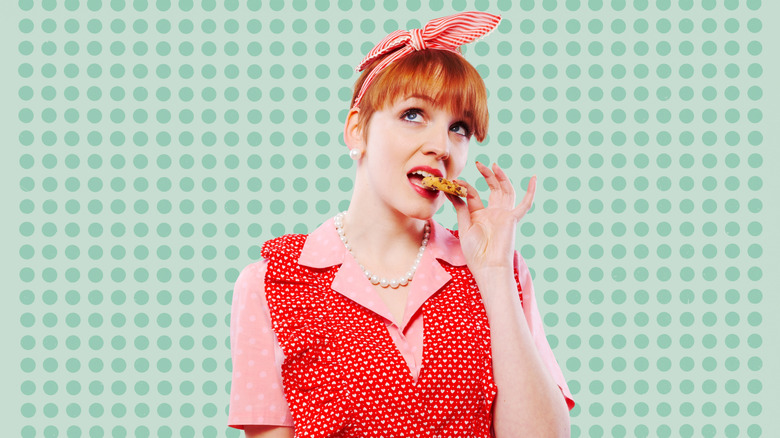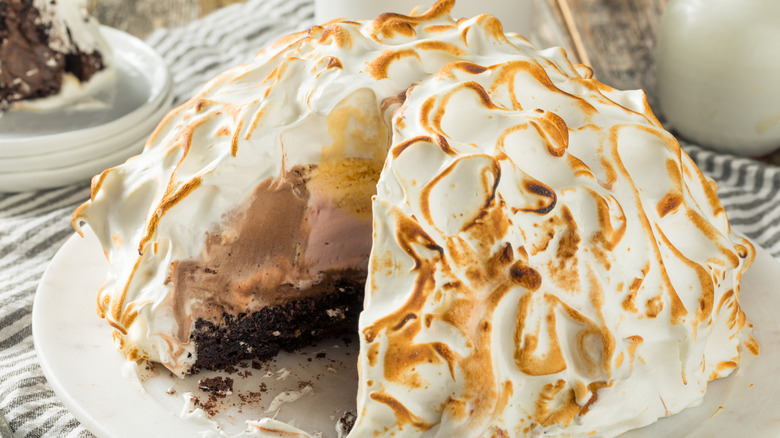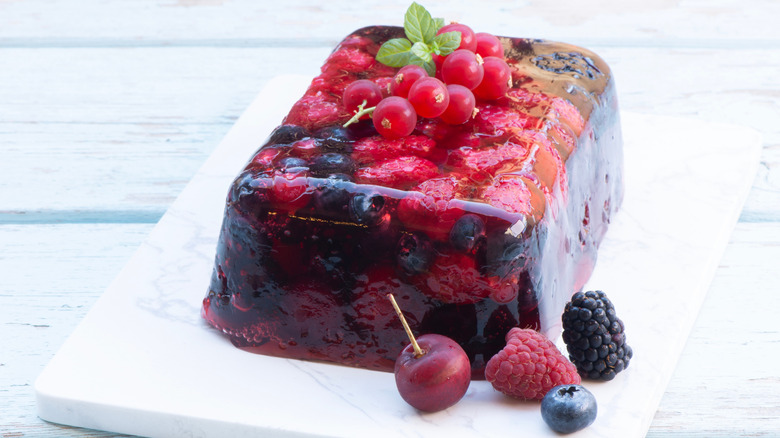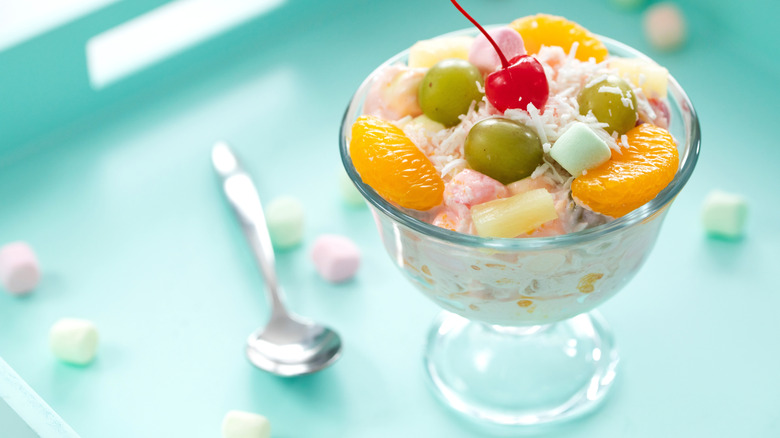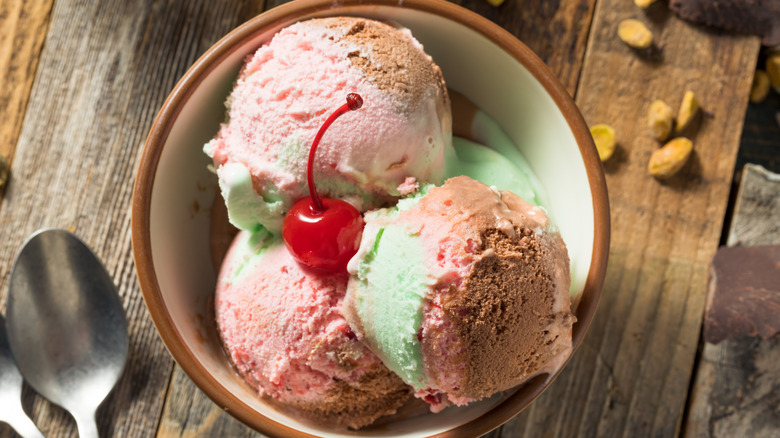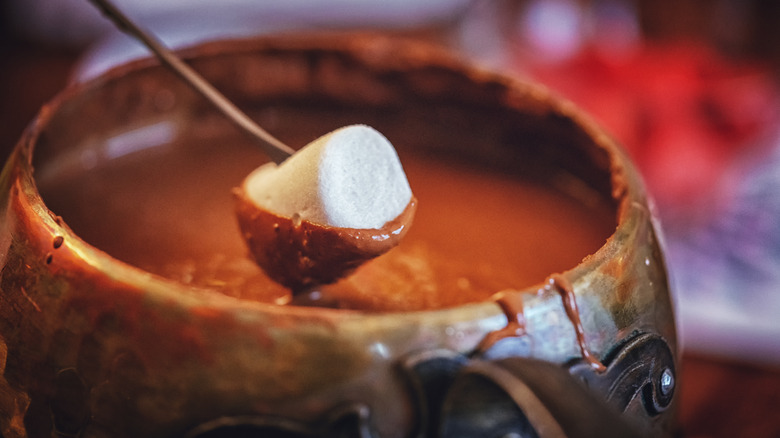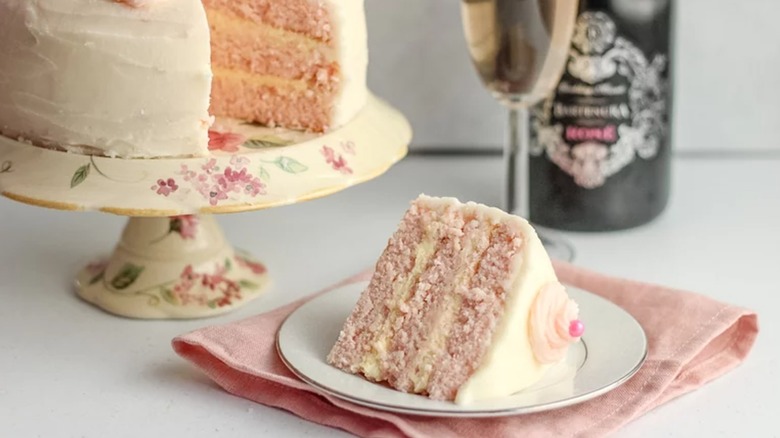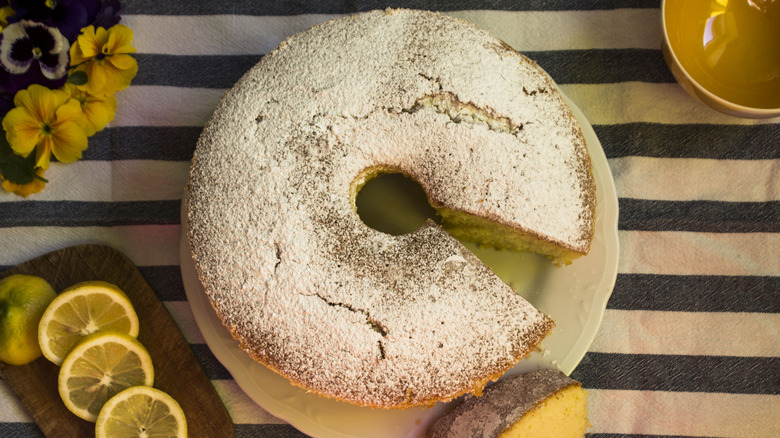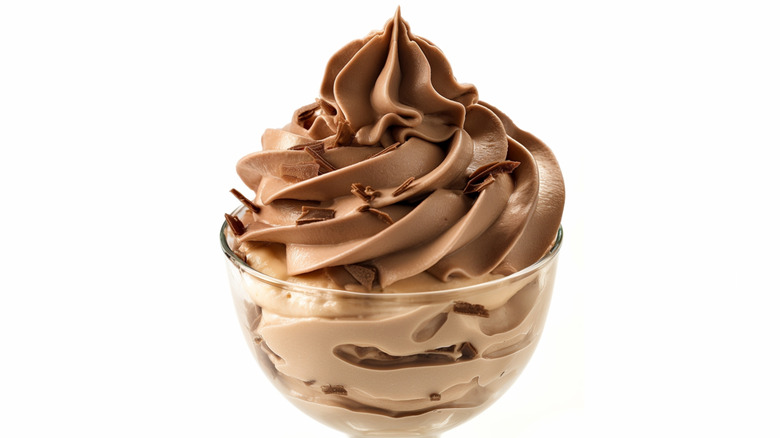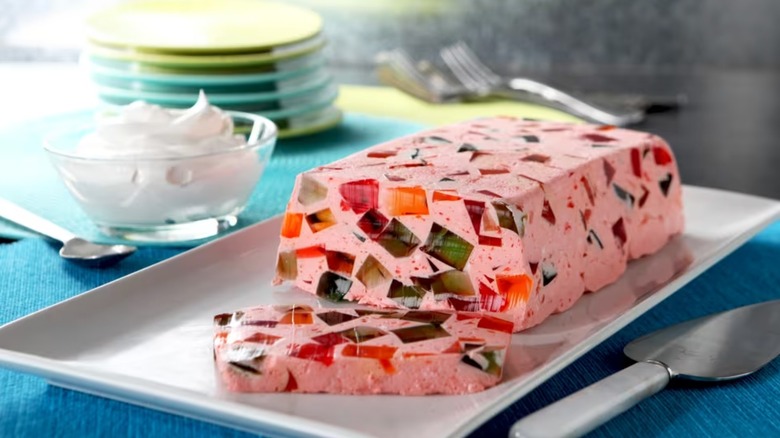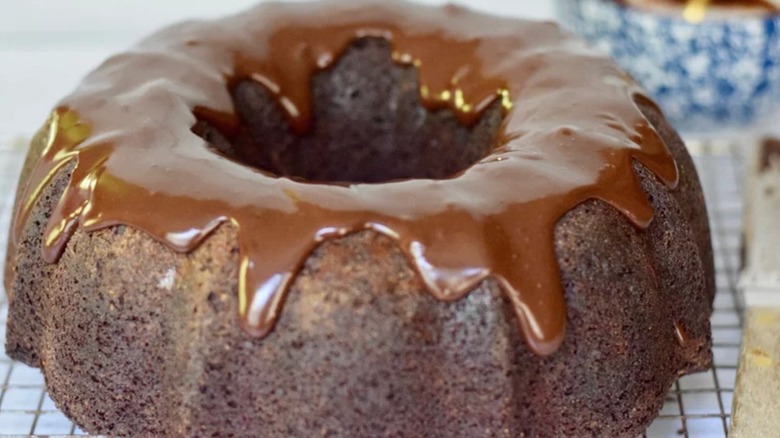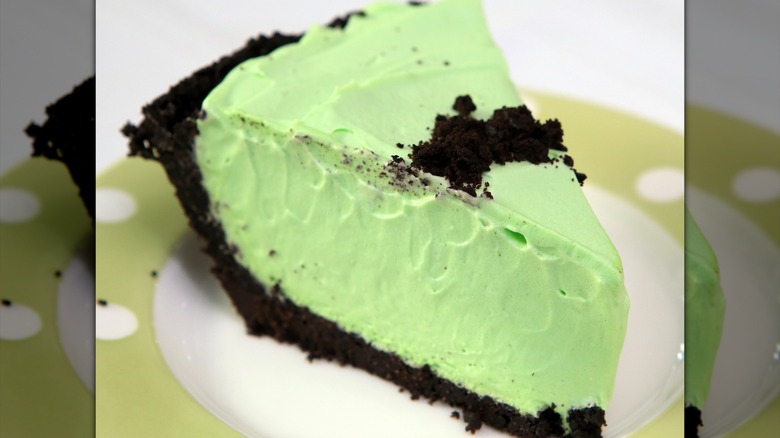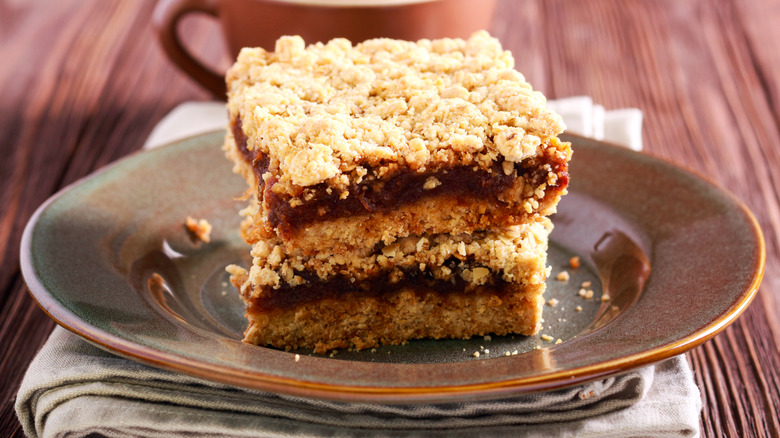Vintage 1960s Desserts We Want Back
Whether you prefer simple sweet treats like chocolate chip cookies or elaborate culinary experiences found at fine dining restaurants, it's safe to say we have come a long way in the dessert game. While you may think of the big gastronomic trends as cutting edge, some of our favorite dessert trends are an homage to the years past. Big cupcake fan? The automated Sprinkles cupcake machines wouldn't exist today without the rise of the individualized treats we know now as cupcakes in the 1960s.
Bakeries, as places of communal gathering and desserts in general, hold a special place in our hearts thanks to the nostalgia factor. These recipes passed down from generation to generation tie us to our roots and evoke childhood memories while making new memories with loved ones. In honor of this, we looked fondly back on the 1960s desserts that shaped our dessert culture that we think could still stand the test of time. We hope this list serves as a sweet memory of the childhood favorites or reminds you of the "cherry on top" of a visit to your grandparents' house.
Baked Alaska
Though Baked Alaska was first created in the 1800s in celebration of becoming a territory, it rose in popularity in the U.S. after Alaska became the 49th state in the 1950s. People still couldn't get enough of this fun dessert into the '60s. It was called a "surprise cake," as you don't see its ice cream cake interior coming from its torched whipped meringue on the outside, which acts like an insulator. The combination of textures and temperatures makes it unique. It's a dessert that may appear advanced and impress your guests, but it is attainable with a multi-step process and a little bit of pre-planning.
We have started to see a comeback of Baked Alaska in recent years, with seasonal trendy riffs like chai, caramelized peaches, and pumpkin spice. Some restaurants have started putting Baked Alaska back on their dessert menus, but your best bet will likely be to attempt this creation at home.
Jell-O salad and sparkling Jell-O molds
The 1960s and the jiggly dessert Jell-O are almost synonymous. Jell-O had a place on the table in many a household in the 1960s. While you can still find Jell-O available on store shelves (and in hospitals) today, the molded cake formations made with the bundt pan that were so widely popularized in the '60s are not typically on the dessert radar these days.
The iconic Jell-O salad allowed your creativity to shine. You could even make your Jell-O "sparkling" with Champagne and fresh fruit like raspberries for the fancy adult dinner party. Or for a more "kid-friendly" sparkling Jell-O approach, add the lemon-lime soda of your choice, like my grandmother used to. While we may pass on bringing back some of the more unusual pairings like Jell-O with seafood or vegetables, the Jell-O mold cakes entice the little ones with a fun presentation, including see-through additions like fruit or marshmallows. If you aren't convinced to try out Jell-O in its full glory, there are many recipes that are reminiscent of the '60s Jell-O craze but elevated, like these mini Jell-O parfaits or Jell-O poke cakes.
Ambrosia salad
This dish skirts the line between a dessert and a side dish. Whether you consume at the beginning, during, or at the end of your meal, ambrosia salad has probably been brought to a family dinner at some point in the last few decades. A family-style restaurant I worked at in Florida even had it as a side dish in the 2000s, likely to impress its older clientele looking for a taste of home (though I don't recall it being ordered much).
Ambrosia salad isn't really a "salad" that we think of now, as it contains no vegetables. With its sweet notes of fruit, whipped topping with sour cream and Cool Whip starting in 1966, coconut, and miniature marshmallows, the ambrosia salad is customizable based on your chosen fruits (usually tropical citrus forward with oranges and pineapple). It is popular around the holidays in Southern cuisine as a traditional side, but has undergone many variations over the years by chefs as a tribute. You may see takes on ambrosia salad using more exotic fruit varieties than the mandarin orange and canned pineapple that once graced this dish, but overall, this side dish is waiting for its resurgence outside of the '50s/'60s diner crew.
Spumoni
Spumoni wasn't invented in the 1960s — its origins reportedly date back to the late 19th century, when Italians first crafted this layered ice cream treat, and later brought its recipe along when immigrating to the States. However, during the '60s, spumoni was a particularly popular dessert at steakhouses and supper clubs ... and while its close cousin of Neapolitan ice cream is still sold by retailers nationwide, people complain that it's surprisingly difficult to get a single scoop of spumoni nowadays.
What set spumoni apart from your average frozen confection is the rather involved process of producing it. With its name derived from the Italian word "spuma" (meaning "foam"), to make spumoni correctly, three different flavors of gelato must be blended with whipped cream before being combined into a fluffy and sweet frozen treat. After the gelato is perfectly airy, mix-ins like nuts, amaretto cookies, and candied fruit are added into the creamy delight before it's frozen solid, offering additional texture that transcends your typical ice cream scoop.
The most traditional flavors of gelato used for this are pistachio, vanilla, and cherry; not coincidentally, when these are layered in the proper order, spumoni closely resembles an Italian flag. While spumoni may not be easy to find at stores, if you have a bit more than six hours to spare, it's possible to whip up your own spumoni-style Italian cream cake recipe. When National Spumoni Day rolls around on August 21, you'll be ready.
Chocolate fondue
This vintage dessert is arguably still relevant, as there is a whole restaurant dedicated to the fondue pot (we're looking at you, The Melting Pot). Fondue originated in Switzerland as a melted cheese dip, but didn't reach the Americas until the late '60s/early '70s. But fondue actually rose to the height of its popularity after debuting at the 1964 New York World Fair.
The original chocolate fondue recipe included Toblerone chocolate, heavy cream, and Swiss firewater, but has since been modified to include all types of sweet and salty varieties like peanut butter or caramel, as well as other types of chocolate like dark chocolate or milk chocolate. You can usually find chocolate fondue served with graham crackers, fruit like bananas or strawberries, angel food cake or pound cake, brownies, and even Rice Krispies treats. The customization makes chocolate fondue an easy way to please all palates. This dessert deserves a place at your dinner if you want to enhance a party with an interactive after-dinner display that will grasp the attention of kids of all ages.
Pink Champagne cake
If you are looking for a dessert for a guest whose favorite color is pink, look no further than this classic party cake for your next birthday, baby shower, or bridal party. Pink Champagne cake contains everything it sounds like from its name (Champagne or sparkling rosé) and gains its pink hue naturally from strawberries (or you can cut corners and use a touch of food coloring). The cake is known for its airy texture from the sparkling wine and egg whites. Pink Champagne cake was traditionally paired with a Bavarian cream or coconut filling, but in recent years, buttercream has been a substitute for the filling and icing.
The pink Champagne cake is thought to have originated on the West Coast in the 1950s and 1960s. It was so popular in the West, it was said the pink Champagne cake was one of the most requested recipes from the Los Angeles Times decades ago. The pink Champagne cake had a reign of popularity across the country from 1961 to 1965. Though maybe not as much of a mainstay these days, we think this classy pink cake is the perfect choice for your next party that needs a splash of color and some bubbly to celebrate.
Chiffon cake or pie
The chiffon cake or pie has roots tied to the West Coast as early as the 1920s, as it was well-loved by Hollywood stars but was kept a secret for two decades. Once Betty Crocker got the recipe in the 1950s from the baker himself, the chiffon cake exploded in popularity with baking contests. The secret ingredient was using vegetable oil instead of shortening. The recipe, called the "first new cake recipe in 100 years," also separated the eggs from the egg whites. The popularity of this dessert continued on to dining tables throughout the '60s, but has since become more of a rarity. Though you will see chiffon cakes in specialty bakeries, you will likely be hard-pressed to find them at your local grocers or in restaurants.
If you are more of a pie person, the chiffon pie version was big in Southern cuisine in the 1960s but also had West Coast roots from the baker known as the "Pie King." The pie is known for its light, airy filling thanks to the use of gelatin. Typically, the chiffon pie filling was flavored with lemon or chocolate and had whipped cream folded in for a creamy, rich texture. A graham cracker crust was the popular choice for this pie for the perfect texture combination of a flaky crust and cool, smooth filling. Baking giant Duncan Hines popularized the chiffon pie, with the 1948 recipe still circulating on the internet for a taste of nostalgia.
Chocolate mousse
Chocolate mousse hit the height of its popularity in the mid-20th century thanks to the Betty Crocker cookbook of the 1950s and a 1961 Julia Child cookbook. You would be hard-pressed not to find chocolate mousse on a trendy dessert menu or at a dinner party through the '70s, but then it slipped out of the limelight. The reason exactly why is unclear, but some have attributed it to the diet culture that seeped into the 1980s.
The good news is that chocolate mousse appeared to be making a comeback in recent years (but typically without the raw egg yolks or by using pasteurized eggs). The authentic French recipes a la Julia Child typically include some sort of liqueur and good quality chocolate. But there are plenty of quick and easy chocolate mousse recipes that take less technique, but are still tasty and pay tribute to the treat of the '60s. Serve your chocolate mousse of choice in vintage glass dessert cups with a dollop of whipped cream for the full retro vibe.
Crown jewel cake
The Crown Jewel Cake is another fun Jell-O-themed dessert of the 1960s with whimsical colors and unique textures. This cake, also called the Broken Window Glass Cake for its mosaic-like patterns, was so popular in the '50s and '60s that it even ran on the back of the Jell-O boxes. The Crown Jewel Cake has layers of fluffy white cake, a creamy filling, and bold-colored gelatin cubes throughout that sparkle like jewels. Many remember this cake being served as a sweet and savory salad with lettuce topping or in the dessert course with whipped topping sans lettuce. You can utilize a springform pan, a mold, or a pie pan.
To recreate the Crown Jewel Cake, you can use boxed cake mix and boxed gelatin for a shortcut. Some recipes call for sprinkling chopped nuts or chocolate syrup on top for decor. If you don't want to mess with cake and a crust, there is a Crown Jewel Dessert that offers the same multi-colored Jell-O artwork within whipped topping. Whichever take on the Crown Jewel you choose, the fun colors and the exciting surprise of what slice of artwork you will get are sure to captivate the adults and the kids even today.
Tunnel of fudge cake
This cake is a home run for the chocoholics. The Tunnel of Fudge cake rose to fame in the 1960s, as it was a 1966 Pillsbury Bake-Off Contest winner in Houston. A clever baking technique separates the chocolate cake batter into two portions with hot fudge in the middle and a trail of walnuts. The key to baking the Tunnel of Fudge cake to perfection is the bundt pan, which became a household staple after the Pillsbury contest, thanks to this cake.
The discontinuation of the necessary Pillsbury Double Dutch Fudge Buttercream Frosting Mix cramped the Tunnel of Fudge baking style, but Pillsbury then provided a recipe adaptation using powdered sugar and cocoa powder that is still used today. The end result of the Tunnel of Fudge Cake is a fudgy molten core that rivals any molten lava cake found at restaurants today. But be warned if you plan to re-create it at home, Pillsbury recommends not going light on the nuts for the best tunnel cake results.
Grasshopper pie
Don't let the name scare you off of Grasshopper pie. This cool and creamy pie gets its name from the pastel green hue, akin to the grasshopper (not actually containing the bugs themselves), and is inspired by the early 1900s Grasshopper cocktail with crème de menthe and crème de cacao. The exact origin of the Grasshopper pie is unclear, but it is believed to have started circulating in cookbooks in the early 1960s. Its popularity was proven when the St. Petersburg Times was inundated by grasshopper pie recipes in 1968 after a letter from a reader inquired about trying to find a recipe for the pie. Grasshopper pie was still a commonly enjoyed treat into the 1970s, but its popularity appeared to drop after that.
So what makes this pie so popular? It may be the easy, no-bake nature of the grasshopper pie, making it perfect to prepare for a summer day. The pie is set by using melted marshmallows as the base for the filling, with some recipes adding in a touch of white chocolate liqueur. After assembling the pie into a Oreo cookie crust, pop it in the freezer for a few hours before bringing it out to enjoy. While you may see grasshopper pie make an appearance on certain green-themed holidays like St. Patrick's Day, we think the mint and chocolate combination deserves a place on the dessert table year-round.
Date bars
Dates have long been a popular dessert ingredient thanks to their inherent sweetness. Date bars were created by adding the chewy texture of dates with copious amounts of sugar, then combining with a buttery crust, baking, and cutting them into squares. Also known as "matrimonial cake" by Canadians, date bars go back as early as the 1930s, with the bars being a staple in the 1953 "Joy of Cooking" edition. Variations of these date bars included a chocolate date square, as pictured in the Pillsbury National Bake-Off recipe book in 1965.
Other date-themed desserts were also big in the 1960s. My mother-in-law's favorite childhood dessert list included a date torte, which was apparently a popular dessert around the holidays. The secret about the versatility of dates has carried on to current times, with many people finding interesting ways to work them into recipes as a natural sweetener. If you look at many health-focused protein bar labels, you'll likely find dates as an ingredient for their sweetness. You may not think of dates right away when you think of a sophisticated dessert, but we think these buttery "old-fashioned" bars can give a nod to the recipes of the '60s and be a delicious, somewhat healthy treat.
